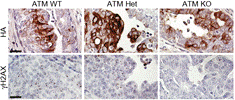Veterinary and Biomedical Sciences, Department of
Date of this Version
8-10-2004
Document Type
Article
Citation
Proceedings of the National Academy of Sciences (August 10, 2004) 101(32): 11,749-11,754. DOI: 10.1072pnas.040383310.
Abstract
A humanized mouse bearing the HLA-DR2 (DRA/DRB1*1501) pro- tein associated with multiple sclerosis (MS) and the myelin basic protein (MBP) 85–99-specific HLA-DR2-restricted T cell receptor from an MS patient has been used to examine the effectiveness of modified amino acid copolymers poly(F,Y,A,K)n and poly- (V,W,A,K)n in therapy of MBP 85–99-induced experimental auto-immune encephalomyelitis (EAE) in comparison to Copolymer 1 [Copaxone, poly(Y,E,A,K)n]. The copolymers were designed to optimize binding to HLA-DR2. Vaccination, prevention, and treatment of MBP-induced EAE in the humanized mice with copolymers FYAK and VWAK ameliorated EAE more effectively than Copolymer 1, reduced the number of pathological lesions, and prevented the up-regulation of human HLA-DR on CNS microglia. Moreover, VWAK inhibited MBP 85–99-specific T cell proliferation more efficiently than either FYAK or Copolymer 1 and induced anergy of HLA-DR2-restricted transgenic T cells as its principle mechanism. In contrast, FYAK induced proliferation and a pronounced production of the antiinflammatory T helper 2 cytokines IL-4 and IL-10 from nontransgenic T cells as its principle mechanism of immunosup- pression. Thus, copolymers generated by using different amino acids inhibited di
Included in
Biological Phenomena, Cell Phenomena, and Immunity Commons, Immune System Diseases Commons, Medical Biochemistry Commons, Medical Molecular Biology Commons, Medical Neurobiology Commons, Nervous System Diseases Commons


Comments
Copyright 2004, PNAS. Used by permission.